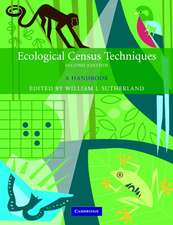Genetics, Demography and Viability of Fragmented Populations: Conservation Biology, cartea 4
Editat de Andrew G. Young, Geoffrey M. Clarkeen Limba Engleză Paperback – 11 oct 2000
| Toate formatele și edițiile | Preț | Express |
|---|---|---|
| Paperback (1) | 505.11 lei 43-57 zile | |
| Cambridge University Press – 11 oct 2000 | 505.11 lei 43-57 zile | |
| Hardback (1) | 1017.99 lei 43-57 zile | |
| Cambridge University Press – 11 oct 2000 | 1017.99 lei 43-57 zile |
Din seria Conservation Biology
- 11%
 Preț: 510.79 lei
Preț: 510.79 lei -
 Preț: 396.12 lei
Preț: 396.12 lei - 11%
 Preț: 474.83 lei
Preț: 474.83 lei - 18%
 Preț: 997.88 lei
Preț: 997.88 lei -
 Preț: 428.90 lei
Preț: 428.90 lei - 18%
 Preț: 957.44 lei
Preț: 957.44 lei - 11%
 Preț: 511.40 lei
Preț: 511.40 lei - 11%
 Preț: 521.80 lei
Preț: 521.80 lei - 15%
 Preț: 532.38 lei
Preț: 532.38 lei - 18%
 Preț: 1233.37 lei
Preț: 1233.37 lei - 11%
 Preț: 519.62 lei
Preț: 519.62 lei - 11%
 Preț: 482.28 lei
Preț: 482.28 lei - 18%
 Preț: 948.92 lei
Preț: 948.92 lei - 11%
 Preț: 599.15 lei
Preț: 599.15 lei - 14%
 Preț: 772.46 lei
Preț: 772.46 lei - 11%
 Preț: 425.79 lei
Preț: 425.79 lei - 15%
 Preț: 644.49 lei
Preț: 644.49 lei - 11%
 Preț: 526.94 lei
Preț: 526.94 lei - 11%
 Preț: 597.21 lei
Preț: 597.21 lei -
 Preț: 383.32 lei
Preț: 383.32 lei -
 Preț: 364.04 lei
Preț: 364.04 lei - 11%
 Preț: 475.17 lei
Preț: 475.17 lei - 15%
 Preț: 646.62 lei
Preț: 646.62 lei - 18%
 Preț: 942.94 lei
Preț: 942.94 lei - 11%
 Preț: 600.56 lei
Preț: 600.56 lei - 24%
 Preț: 1058.91 lei
Preț: 1058.91 lei - 18%
 Preț: 1240.62 lei
Preț: 1240.62 lei - 11%
 Preț: 513.79 lei
Preț: 513.79 lei -
 Preț: 459.88 lei
Preț: 459.88 lei - 18%
 Preț: 944.36 lei
Preț: 944.36 lei - 24%
 Preț: 790.95 lei
Preț: 790.95 lei - 11%
 Preț: 567.97 lei
Preț: 567.97 lei
Preț: 505.11 lei
Preț vechi: 567.55 lei
-11% Nou
Puncte Express: 758
Preț estimativ în valută:
96.65€ • 101.17$ • 80.45£
96.65€ • 101.17$ • 80.45£
Carte tipărită la comandă
Livrare economică 31 martie-14 aprilie
Preluare comenzi: 021 569.72.76
Specificații
ISBN-13: 9780521794213
ISBN-10: 0521794218
Pagini: 460
Ilustrații: 69 b/w illus. 34 tables
Dimensiuni: 152 x 229 x 26 mm
Greutate: 0.69 kg
Ediția:New.
Editura: Cambridge University Press
Colecția Cambridge University Press
Seria Conservation Biology
Locul publicării:Cambridge, United Kingdom
ISBN-10: 0521794218
Pagini: 460
Ilustrații: 69 b/w illus. 34 tables
Dimensiuni: 152 x 229 x 26 mm
Greutate: 0.69 kg
Ediția:New.
Editura: Cambridge University Press
Colecția Cambridge University Press
Seria Conservation Biology
Locul publicării:Cambridge, United Kingdom
Cuprins
Foreword P. Brussard; 1. Introduction: genetics, demography and the conservation of fragmented populations G. Clarke and A. Young; Part I. Introductory Concepts: 2. Managing and monitoring genetic erosion W. Sherwin and C. Moritz; 3. Inbreeding and outbreeding depression in fragmented populations M. Dudash and C. Fenster; 4. Demography and extinction in small populations K. Holsinger; 5. The metapopulation paradigm: a fragmented view of conservation biology P. Thrall, J. Burdon and B. Murray; 6. Population viability analysis for conservation: the good, the bad and the undescribed M. Burgman and H. Possingham; 7. Applications of population genetics and molecular techniques to conservation biology P. Hedrick; Part II. Animal Case Studies: 8. Inbreeding in small populations of red-cockaded woodpeckers: insights from a spatially-explicit individual-based model S. Daniels, J. Priddy and J. Walters; 9. Genetic erosion in isolated small mammal populations following rain forest fragmentation S. Srikwan and D. Woodruff; 10. The Tumut experiment - integrating demographic and genetic studies to unravel fragmentation effects: a case study of the native bush rat D. Lindenmayer and R. Peakall; 11. Demographic evidence of inbreeding depression in wild golden lion tamarins J. Dietz, A. Baker and J. Ballou; 12. Inferring demography from genetics - a case study of the endangered golden sun moth, Synemon plana G. Clarke; 13. Genetic population structure in desert bighorn sheep: implications for conservation in Arizona G. Gutierreez-Espelta, S. Kalinowski and P. Hedrick; Part III. Plant Case Studies: 14. Limited forest fragmentation improves reproduction in the declining New Zealand mistletoe Peraxilla tetrapetala (Loranthaceae) D. Kelly, J. Ladley, A. Robertson and D. Norton; 15. Ecology and genetics of Grevillea (Proteaceae); 16. Genetic and demographic influences on population persistence: gene flow and genetic rescue in Silene alba C. Richards; 17. Fragmentation in central American dry forests - genetic impacts on Swietenia humulis (Meliaceae) G. White and D. Boshier; 18. Population viability analysis of the rare Gentiana pneumonanthe: importance of genetics, demography and reproductive biology J. Oostermeijer; 19. Genetic erosion, restricted mating and reduced viability in fragmented populations of the endangered grassland herb Rutidosis leptorrhynchoides A. Young, A. Brown, B. Murray, P. Thrall and C. Miller; Part IV. Conclusions and Future Directions: 20. What do we know about the genetic and demographic effects of habitat fragmentation and where do we go from here? A. Young and G. Clarke; Index.
Recenzii
'I really enjoyed some of the case studies … understanding deterministic decline and its cure represents the greatest challenges to conservation biology. However, Clarke and Young show that understanding small-population processes might help maintain populations until 'the patient' can be cured.' Ken Norris, Biologist
Descriere
A detailed introduction to the genetic and demographic issues relevant to the conservation of fragmented populations.













